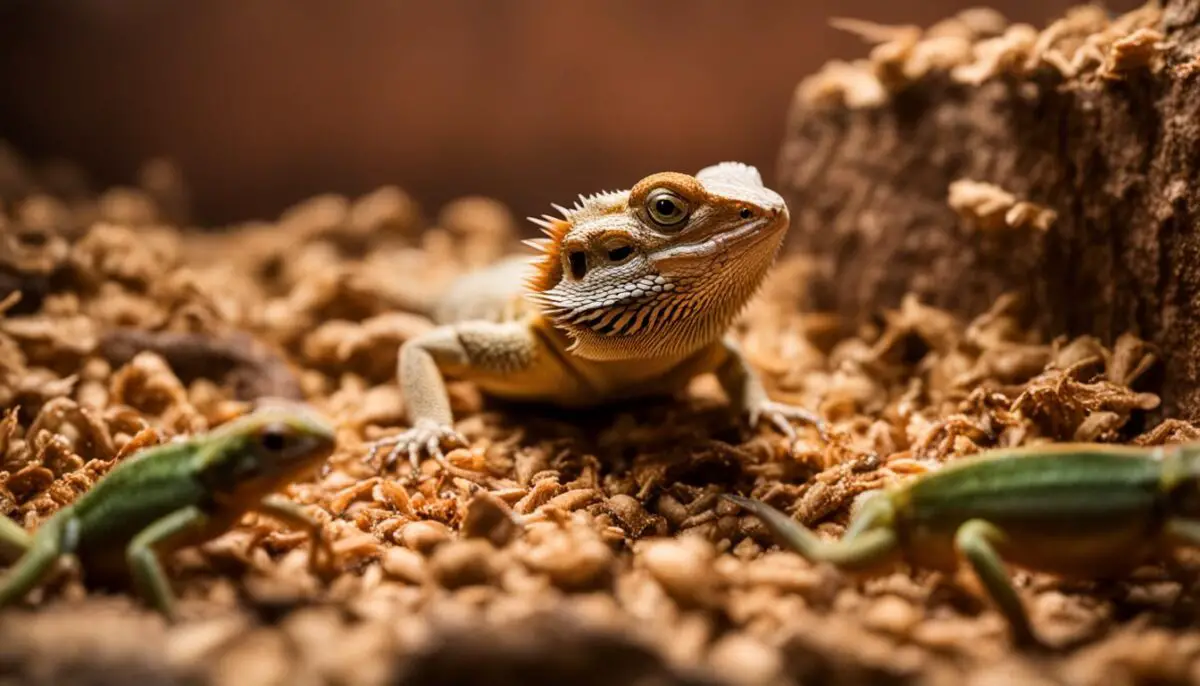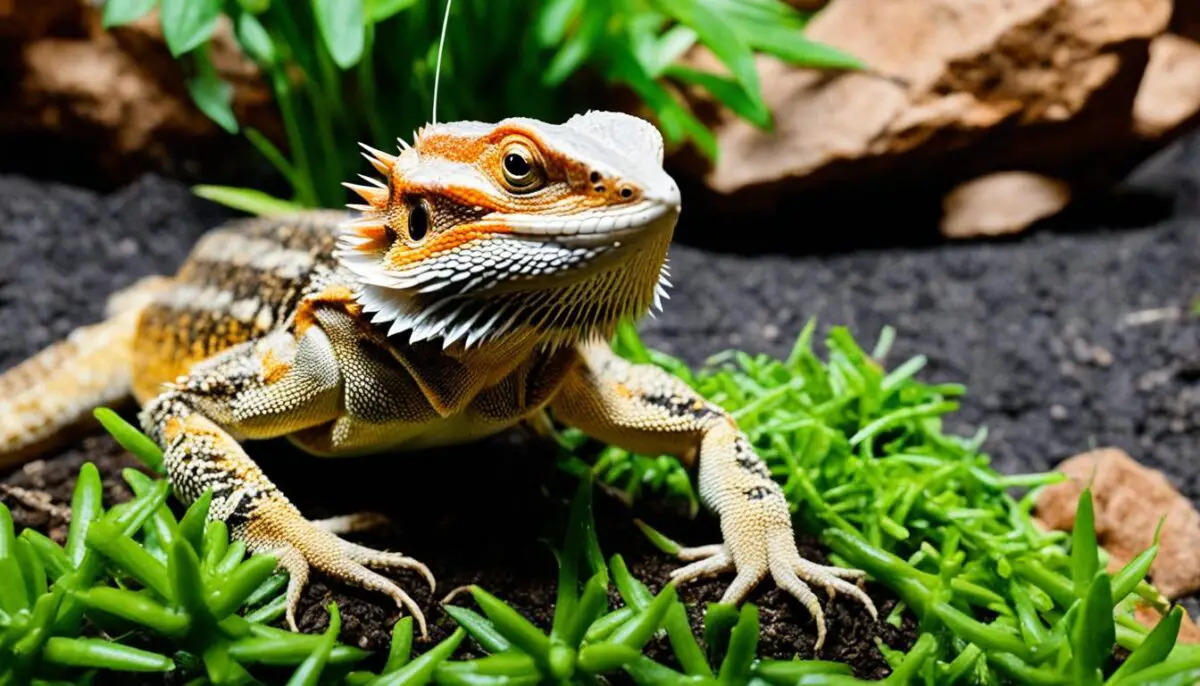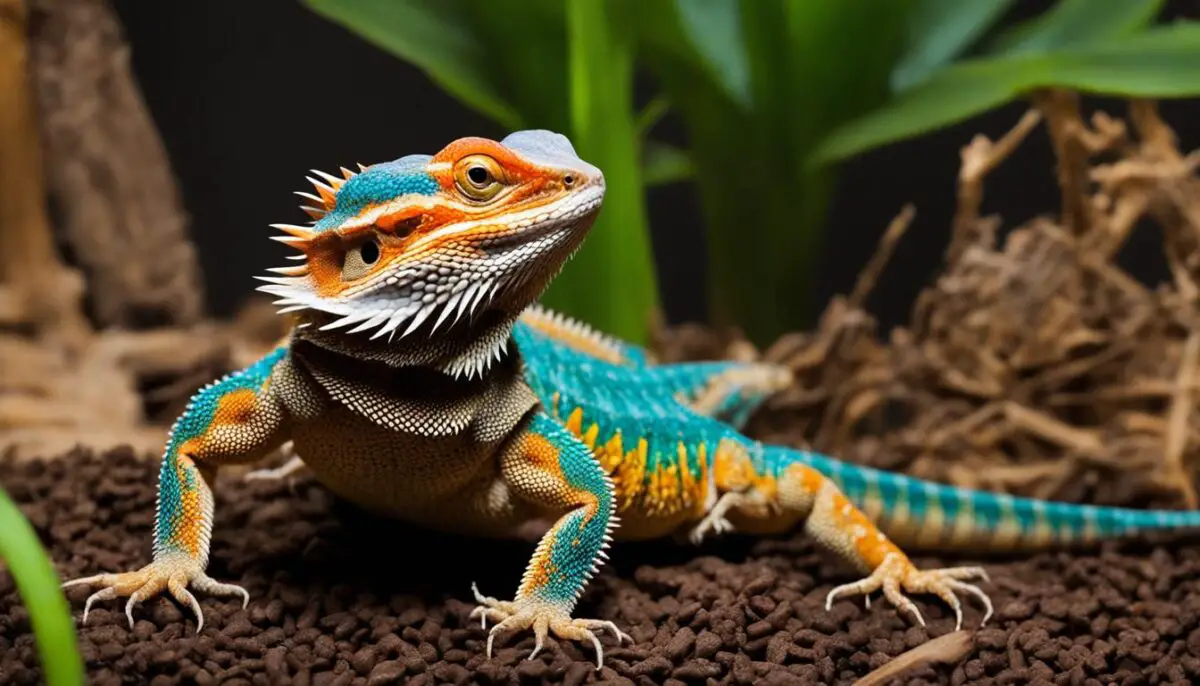Welcome to our comprehensive guide on feeding crickets to bearded dragons! Bearded dragons are popular pets known for their unique personalities and dietary needs. A bearded dragon’s diet primarily consists of various live insects, with crickets being one of the top choices. Understanding how to properly feed crickets to your bearded dragon is crucial for their overall health and well-being.
Key Takeaways:
- There are three main methods to feed live insects to bearded dragons: using tweezers, dropping them in the tank, or using a feeding dish.
- Having a feeding schedule, dusting live insects with calcium powder, and limiting feeding time to 10-15 minutes are essential for a healthy diet.
- Baby dragons require more frequent feedings, while adult dragons need fewer live insect feedings to avoid obesity.
Feeding Live Insects One by One with Tweezers
Feeding bearded dragons live insects one by one using tweezers is a highly recommended method, especially for baby dragons. This approach ensures that the prey cannot escape and helps regulate the baby dragon’s intake, preventing overeating. It’s crucial to avoid feeding the insects by hand to prevent accidental bites.
Having a regular feeding schedule and dusting the live insects with calcium powder are also essential for a healthy diet.
Feeding your bearded dragon with tweezers allows you to have better control over the feeding process. You can select the appropriate size of insects and present them one by one for the dragon to consume. This method also reduces the risk of accidental ingestion of substrate or other foreign objects.
“Feeding bearded dragons with tweezers is an effective way to ensure they receive the right amount of insects without overfeeding them. It also helps promote interactive feeding sessions, allowing owners to bond with their dragons.” – Dr. Emma Anderson, Herpetologist
Remember to maintain a feeding schedule to establish a routine for your bearded dragon, which will aid in its overall well-being. Dusting the live insects with calcium powder before feeding provides essential nutrients for your pet’s growth and development.
By feeding live insects one by one with tweezers, you can closely monitor your bearded dragon’s eating habits and adjust the portions accordingly. This method is particularly beneficial during the early stages of a dragon’s life, ensuring they receive adequate nutrition for proper growth and development.
Follow this feeding method for your bearded dragon, along with other essential care practices, to ensure its optimal health and well-being.

| Benefits of Feeding Live Insects One by One with Tweezers: |
|---|
| Allows better portion control |
| Reduces the risk of accidental ingestion of substrate or foreign objects |
| Promotes interactive feeding sessions and bonding with your bearded dragon |
| Aids in monitoring feeding habits and adjusting portions accordingly |
Dropping All the Bugs in the Tank
Feeding your adult bearded dragons or older juveniles live crickets by dropping them directly into the tank is a convenient and effective method. This method is particularly suitable for terrariums that are lined with reptile carpet or substrates, as the live prey can hide or bury themselves, mimicking their natural environment. To ensure a successful feeding session, follow these steps:
- Gather the desired number of live crickets for your bearded dragon’s meal.
- Before releasing them into the tank, lightly dust the crickets with calcium powder to provide essential nutrients for your pet.
- Once dusted, shake off the excess powder and carefully release the crickets into the cage.
Remember, it’s essential to monitor the feeding time to prevent overeating and obesity in your bearded dragon. Typically, it’s best to allow your dragon to feed for about 10-15 minutes, removing any uneaten crickets afterwards. Maintaining a healthy feeding schedule ensures your bearded dragon receives adequate nutrition without excessive weight gain.

Dropping crickets directly into the tank provides an opportunity for your bearded dragon to engage in natural hunting behaviors, promoting mental stimulation and exercise. Just make sure to create an environment where the crickets cannot escape, ensuring they remain accessible for your dragon’s enjoyment.
Using a Feeding Dish
When it comes to proper feeding of crickets to bearded dragons, using a feeding dish can be a convenient and effective option. This method is particularly suitable for juvenile dragons who are still in the learning phase of hunting. By using a feeding dish, you can regulate your dragon’s intake without having to place the insects in the tank one by one.
In addition to crickets, it is recommended to include a variety of vegetables and greens in the feeding dish. This creates a protein-infused salad for your pet, offering them a well-rounded and nutritious meal. Bearded dragons have a voracious appetite, and the feeding dish allows them to enjoy their food while ensuring they get the necessary nutrients.
Using a feeding dish also minimizes the risk of insects escaping or hiding in various fixtures within the tank. It makes it easier to monitor the feeding process and removes the need for manual handling, reducing the chances of accidental bites or injuries.
Remember to provide fresh food in the feeding dish daily and clean the dish regularly to maintain hygiene. This feeding method not only ensures the proper nutrition of crickets for bearded dragons but also offers the benefit of convenience and ease of feeding.
Give your bearded dragon a satisfying and nutritious meal by utilizing a feeding dish as part of their feeding routine.
Benefits of Using a Feeding Dish:
- Regulates your dragon’s intake
- Prevents insects from escaping
- Reduces the risk of accidental bites or injuries
- Allows for easy monitoring of feeding process
- Provides a variety of vegetables and greens in a convenient manner
- Offers a well-rounded and nutritious meal

Live Insect Feeding Tips
Feeding your bearded dragon live insects is an important part of their diet, regardless of the feeding method you choose. To ensure the best mealtime experience for your scaly friend, here are some helpful tips:
- Establish a Feeding Schedule: Have a feeding schedule tailored to your bearded dragon’s health needs. This helps maintain a regular feeding routine and ensures that your dragon receives the necessary nutrients.
- Dust the Live Insects: Before offering the live insects to your dragon, lightly dust them with calcium powder or vitamin D3. This enhances the nutritional value of the insects and helps support your dragon’s bone health.
- Limit Feeding Time: Bearded dragons should have a limited feeding time of 10-15 minutes per meal. This prevents overeating and allows your dragon to properly digest their food.
- Regulate Insect Size: For baby dragons, it’s crucial to select insects that are an appropriate size. Avoid offering insects that are larger than the space between your dragon’s eyes to prevent choking hazards.
By following these live insect feeding tips, you can provide your bearded dragon with a balanced and nutritious diet. Remember, their well-being depends on a variety of factors, including diet, habitat, and regular veterinary check-ups.

Potential Feeder Problems
Feeding live insects to your bearded dragon can sometimes come with its own set of challenges. Here are some common issues that you may encounter and how to handle them:
- Insects may crawl away: It’s not uncommon for crickets and other live insects to try to escape the enclosure. To prevent this, consider using the feeding dish or tweezer method mentioned earlier in this guide. This will help you have better control over the insects and minimize the chances of them running away.
- Insects hiding in various fixtures: Bearded dragons are clever hunters, and sometimes live insects may find hiding spots in the tank fixtures such as logs or rocks. Regularly inspect these hiding places before and after feedings to ensure that no insects are left behind. Removing uneaten insects promptly is important for maintaining cleanliness in the enclosure.
- Insects burying themselves in the substrate: If your bearded dragon’s enclosure has a loose substrate, such as sand or soil, live insects may bury themselves. This can make it challenging for your pet to find and eat them. To avoid this, you could consider using alternative substrates like reptile carpet or newspaper that are not suitable for insects to burrow into.
By being observant during feeding times and promptly addressing any potential issues, you can ensure that your bearded dragon has a successful and hassle-free feeding experience.
| Feeder Problem | Solution |
|---|---|
| Insects crawling away | Use the feeding dish or tweezer method for better control |
| Insects hiding in fixtures | Regularly inspect and remove uneaten insects from hiding places |
| Insects burying in substrate | Consider using non-burrowing substrates like reptile carpet or newspaper |
Conclusion
Feeding crickets to bearded dragons provides numerous benefits for your scaly friend. Not only do crickets serve as a good source of nutrition, but they also offer stimulation during mealtime. By following the proper feeding methods and tips, you can ensure your bearded dragon has a healthy and balanced diet.
Whether you choose to feed live insects using tweezers, drop them in the tank, or utilize a feeding dish, it’s important to monitor the feeding schedule. Consistency is key to maintaining your bearded dragon’s well-being. Additionally, be sure to dust the insects with calcium powder to provide essential nutrients.
Introducing a variety of vegetables and greens alongside live insects further enhances your bearded dragon’s diet. This combination creates a protein-infused salad, which adds nutritional value to their meals. Remember, mealtime is an opportunity to bond and have fun with your scaly pet.
Embrace the benefits of crickets for bearded dragons as you provide your pet with a well-rounded and fulfilling diet. By catering to their unique dietary needs, you can ensure your bearded dragon stays happy, healthy, and thriving for years to come.
FAQ
How should I feed live insects to my bearded dragon?
There are three main ways to feed live insects to your bearded dragon: using tweezers to place them one by one into the tank, dropping them all in the tank, or placing them in a feeding dish with veggies.
What is the feeding schedule for bearded dragons?
Baby dragons should be fed live insects three to four times daily, juvenile dragons up to three times a day, and adult dragons once a day or every other day to avoid obesity.
How do I feed live insects one by one with tweezers?
Use tweezers to place the insects one by one into the tank. This method is beneficial for baby dragons to prevent overeating and accidental bites.
How do I drop all the bugs in the tank?
Collect the desired number of insects, give them a dusting of calcium powder, and shake them off into the tank. This method is suitable for adult dragons and terrariums with reptile carpet or substrates.
How do I use a feeding dish for live insects?
Fill a feeding dish with a few insects and veggies. This method is suitable for juvenile dragons who are still learning to hunt and helps regulate their intake.
What are some live insect feeding tips for bearded dragons?
It’s important to have a feeding schedule, dust the insects with calcium powder or vitamin D3, and limit the feeding time to 10-15 minutes. Additionally, choose appropriate-sized crickets and include a variety of vegetables and greens in the feeding dish.
What are potential problems when feeding live insects to bearded dragons?
Insects may crawl away, hide in fixtures, or bury themselves. To prevent these issues, use the feeding dish or tweezers, be observant during feeding times, and remove any uneaten insects.


